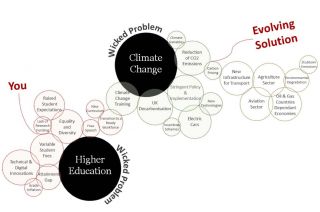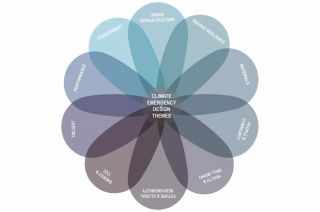
www.buildingsandcities.org/insights/commentaries/climate-architecture-education.html
Climate Change and Architectural Education

Firm and rapid action by the RIBA and other accreditation bodies is needed for curriculum change.
The B&C special issue EDUCATION & TRAINING: MAINSTREAMING ZERO CARBON could not be more timely, as the Royal Institute of British Architects (RIBA) is rethinking how best to reframe its education and also at a time of crisis management and rapid change in universities in the light of the pandemic. Flora Samuel and Lorraine Farrelly (both at the University of Reading) argue that a radical reframing of built environment competencies, allowing new hybrid routes to competency, has to be part of this process.
Students are deeply worried about the climate change emergency and are hungry to develop the knowledge skills and competencies to deliver a zero-carbon built environment. As architectural educators, this has repeatedly been impressed upon us over many years. In the UK Prime Minister Boris Johnson has just announced a ten point set of objectives for what he calls a 'green industrial revolution', suggesting that zero carbon skills are likely to be even more in demand than they have been. That training in zero carbon has been so thin and patchy is a sad indictment of architectural education. As the most highly trained members of the construction team, the expectation is that architects would be leading the way on zero carbon, but too little is happening too slowly.
In order to meet climate change targets that all new buildings must operate at net zero carbon by 2030, a consortium of London practices have come together to develop a published roadmap for effecting this transformation (LETI, 2020). There are great zero carbon skills in practice which need to be brought into schools so that students understand the theories of environmental design and also how to apply them in a practice context.
Professional requirements
The RIBA has posited a new Education and Professional Development Framework (RIBA, 2020), a 'single standard covering pre and post registration education'. Within it 'the Climate Literacy required to enable Chartered Architects to meet the 2030 Climate Challenge' will be listed as a 'Mandatory Competence'.1 This positive development has major implications for schools of architecture in the UK and beyond. The trouble is that so many architecture schools are not in a good place to deal with this, both as a result of the pandemic and year on year budgetary squeezes. The ability of some schools to deliver on these high aspirations is low. Strong leadership is needed from within architecture schools to drive this change past a range of institutional impediments from within their institutions, to ensure that these changes to curriculum are prioritised as they will need to be implemented when they become part of the professional validation and prescription requirements
Universities setting an example
The excessively slow rise of zero carbon education has to start with the universities themselves which are only just beginning to recognise the positive impacts of various green university league tables in terms of admissions and income. Through their campuses and their buildings universities should be all set to model zero carbon innovation.2 Indeed a few are, but they are managed by directors of estates who, in our experience, value completion on time and for a small budget way over everything else (and rarely if ever work with their architecture or construction schools).
The Higher Education Design Quality Forum is working hard to model the benefits of 'The Zero Carbon University', the name of their 2021 conference. We hope that they can change hearts and minds but this will be difficult in shrinking, cash strapped, universities that are wondering how best to reduce their existing estate. The building of a zero-carbon estate could provide a serious learning opportunity for students if only university managers would let them in on the process.
Teaching and learning
Schools of architecture need to have the expertise within them to deliver to zero carbon competences and develop the skills needed to teach students to apply these issues to their own designs - from conceptual to detailed design. The most critical thing in promoting zero carbon education is, in our view, investment in teaching staff.
Many practitioners become progressively embedded in teaching while losing the original edge that their practice brought with them. If they have no support to develop their approaches to pedagogy or practice, their skills can rapidly outdate. This means they are not capable of integrating zero carbon concerns into their design teaching. (Design represents 50% of the curriculum requirement in the current RIBA and ARB validation process.) Funding for professional development needs to be prioritised to ensure these staff are regularly upskilled, for example through Passivhaus training or through periods of work experience in offices. The need for basic literacy in zero carbon, at the core of Grant's (2020) paper 'Mainstreaming environmental education for architects: the need for basic literacies', is of equal importance for staff and students alike. Although schools have a regular throughput of practitioners who assist with the teaching of the design module they rarely have any real say in the project briefs, something that is often left to full time staff. One solution to this is to develop some of the content of the design curriculum with practitioners to ensure students are learning the skills they need. This would also harness the experience of practice and their specialist sustainable design tools to inform the design studio projects. At the University of Reading this has been done by bringing in practices like Haworth Tompkins, ACG and Invisible Studio to assist in the co-creation of architectural education, enabling students to develop specific knowledge in the process. Students have been using tools and approaches from practice, e.g. The Living Building Challenge to raise awareness of approaches to sustainable design.3
In the UK academics tend to be classified as 'teaching only' or 'teaching and research'. Those that are research oriented are equally challenged to deliver zero carbon skills, unless it happens to be their research speciality. The emphasis of successive national research excellence assessments and the pressure on staff to publish academic research have changed the culture of architecture schools. It is very difficult to be both a practitioner and teacher at the same time, a situation compounded by the introduction of professional indemnity insurance. It is no longer possible to have a foot in practice, meaning that these staff are equally unlikely to be able to deliver the zero-carbon education that is so urgently needed. At the same time research into pedagogy is considered too flimsy to be included in research excellence assessment submissions, demotivating staff from developing this area of concern. This might in part explain the paucity of abstracts received by the editorial team in this domain.
The Architects Climate Action Network (ACAN) recently ran a workshop with RIBA and SCHOSA (the Standing Conference of Heads of Schools of Architecture). Architecture teaching staff were invited to work with them to develop a set of principles that could be used as a toolkit to support developing the curriculum. The intention is to create some shared objectives across Schools of Architecture and identify challenges to deliver these objectives could be identified. This is a positive step forwards as part of a series of planned workshops to share expertise and approaches .
Requiring a statement about the way each module in a school is addressing the Climate Change Emergency, one of the ACAN recommendations, sends out the right message to students about staff priorities but is insufficient. There are many things that individual teachers can do to promote education for net zero within their individual modules whatever the subject. Even history and theory modules can be used as an opportunity to elucidate the many ways in which architects have tried to connect with nature, the history of sustainability and innovation in this area.
The students themselves have a major role to play in this transformation. There has never been a more sustainability conscious generation than our current cohorts. They need to be assisted in pushing for bottom-up behavioural and institutional change. They can vote with their feet to go to schools with strong Zero Carbon education.
A fit industry?
The Future of Skills Employment in 2030(NESTA, 2017) states:
'Creative, digital, design and engineering occupations have bright outlooks and are strongly complemented by digital technology. Furthermore, architectural and green occupations are expected to benefit from greater urbanisation and a greater interest in environmental sustainability.'
Presumably this includes strictures around zero carbon. Universities have everything to gain by helping them to learn these skills which are widely in demand across the globe.
A strategy is needed to develop zero carbon skills in the construction workforce more widely, as suggested in Mayer's (2020) paper 'Material recovery certificationfor construction workers' that explains the need for certification amongst those tasked with the responsibility of recycling energy intensive building materials. In the UK the National Federation of Builders reports a major lack of skills in the construction industry for delivering greener buildings (NFB, 2019, p. 18). Philip Augar's recent review of post 18 education has revealed that there is much to do in this area, including the strengthening of technical education (Augar et al., 2019, p. 9). Transition funding for Higher Education organisations to upskill their teachers (and researchers) and develop appropriate new curricula would make all of this much easier.
Zero carbon entails more than a technical knowledge and skills. It involves team working, other soft skills, as well as a new emphasis on Post Occupancy Evaluation as Stevenson and Kwok's (2020) editorial 'Mainstreaming zero carbon: lessons for built-environment education and training' suggests. Further, as noted in Green and Sergeeva's (2020) 'The contested privileging of zero carbon: plausibility, persuasiveness and professionalism', narratives and professional identity are key to all this. The delivery of zero carbon requires a radical rethink of the purpose and remit of built environment education away from the financial maximisation model that has been so popular for the last thirty years (epitomised by the construction industry reviews by John Egan and Michael Latham) towards other kinds of value including zero carbon. This special edition of Buildings and Cities provides an important foundation for the work to come. We need to work together to make sure that all schools who educate students in the built environment have a zero carbon education as a norm and support development of the knowledge and expertise needed to deliver that.
Notes
1. In the UK, basic architectural registration is from the Architects Registration Board (ARB). Students must complete Parts 1 ,2 and 3 on a course prescribed by the ARB. Additionally, schools seek RIBA validation for their programmes in order to be seen to deliver a gold standard of education. Outside the UK, courses can choose to be validated by the RIBA for Part 1 and Part 2.
2. As long-term owner-occupiers of their estates, universities are well placed to create a holistic financial approach to their CAPEX (capital expenditure) and OPEX (operating expenditure) budgets.
3. For example: Core Green Building Certification and also the 'Regenerate' toolkit for material circularity.
References
Augar, P. et al. (2019). Review of Post 18 Education and Funding. Presented to parliament by the Secretary of State for Education. London: Her Majesty's Stationary Office. ISBN: 978-1-5286-1322-4. https://tinyurl.com/y3aj6xbo
Grant, E.J. (2020). Mainstreaming environmental education for architects: the need for basic literacies. Buildings and Cities, 1(1), 538-549. https://doi.org/10.5334/bc.41
Green, S.D. and Sergeeva, N. (2020).The contested privileging of zero carbon: plausibility, persuasiveness and professionalism. Buildings and Cities, 1(1), 491-503. https://doi.org/10.5334/bc.49
LETI (2020). Climate Change Design Guide. https://www.leti.london/cedg
Mayer, M. (2020). Material recovery certification for construction workers. Buildings & Cities, (1)1, 550-564. https://doi.org/10.5334/bc.58
NESTA. (2017). The Future of Skills: Employment in 2030.London: Pearson and Nesta. https://futureskills.pearson.com/research/assets/pdfs/technical-report.pdf
NFB (2019). Transforming Construction for a Low Carbon Future. National Federation of Builders. https://www.builders.org.uk/documents/transforming-construction-for-a-low-carbon-future/
RIBA. (2020). The Way Ahead. https://www.architecture.com/-/media/GatherContent/Social-Value-Toolkit-for-Architecture/Additional-Documents/The-Way-Ahead-brochure-4-Sep-20.pdf
RIBA. (2018). Ethics in Architectural Practice. https://tinyurl.com/yagrz9cv
Stevenson, F. and Kwok, A. (2020). Mainstreaming zero carbon: lessons for built environment education and learning. Buildings & Cities, 1(1), 687-696. https://doi.org/10.5334/bc.84
Latest Peer-Reviewed Journal Content
Acceptability of sufficiency consumption policies by Finnish households
E Nuorivaara & S Ahvenharju
Key factors for revitalising heritage buildings through adaptive reuse
É Savoie, J P Sapinski & A-M Laroche
Cooler streets for a cycleable city: assessing policy alignment
C Tang & J Bush
Understanding the embodied carbon credentials of modern methods of construction
R O'Hegarty, A McCarthy, J O'Hagan, T Thanapornpakornsin, S Raffoul & O Kinnane
The changing typology of urban apartment buildings in Aurinkolahti
S Meriläinen & A Tervo
Embodied climate impacts in urban development: a neighbourhood case study
S Sjökvist, N Francart, M Balouktsi & H Birgisdottir
Environmental effects of urban wind energy harvesting: a review
I Tsionas, M laguno-Munitxa & A Stephan
Office environment and employee differences by company health management certification
S Arata, M Sugiuchi, T Ikaga, Y Shiraishi, T Hayashi, S Ando & S Kawakubo
Spatiotemporal evaluation of embodied carbon in urban residential development
I Talvitie, A Amiri & S Junnila
Energy sufficiency in buildings and cities: current research, future directions [editorial]
M Sahakian, T Fawcett & S Darby
Sufficiency, consumption patterns and limits: a survey of French households
J Bouillet & C Grandclément
Health inequalities and indoor environments: research challenges and priorities [editorial]
M Ucci & A Mavrogianni
Operationalising energy sufficiency for low-carbon built environments in urbanising India
A B Lall & G Sethi
Promoting practices of sufficiency: reprogramming resource-intensive material arrangements
T H Christensen, L K Aagaard, A K Juvik, C Samson & K Gram-Hanssen
Culture change in the UK construction industry: an anthropological perspective
I Tellam
Are people willing to share living space? Household preferences in Finland
E Ruokamo, E Kylkilahti, M Lettenmeier & A Toppinen
Towards urban LCA: examining densification alternatives for a residential neighbourhood
M Moisio, E Salmio, T Kaasalainen, S Huuhka, A Räsänen, J Lahdensivu, M Leppänen & P Kuula
A population-level framework to estimate unequal exposure to indoor heat and air pollution
R Cole, C H Simpson, L Ferguson, P Symonds, J Taylor, C Heaviside, P Murage, H L Macintyre, S Hajat, A Mavrogianni & M Davies
Finnish glazed balconies: residents' experience, wellbeing and use
L Jegard, R Castaño-Rosa, S Kilpeläinen & S Pelsmakers
Modelling Nigerian residential dwellings: bottom-up approach and scenario analysis
C C Nwagwu, S Akin & E G Hertwich
Mapping municipal land policies: applications of flexible zoning for densification
V Götze, J-D Gerber & M Jehling
Energy sufficiency and recognition justice: a study of household consumption
A Guilbert
Linking housing, socio-demographic, environmental and mental health data at scale
P Symonds, C H Simpson, G Petrou, L Ferguson, A Mavrogianni & M Davies
Measuring health inequities due to housing characteristics
K Govertsen & M Kane
Provide or prevent? Exploring sufficiency imaginaries within Danish systems of provision
L K Aagaard & T H Christensen
Imagining sufficiency through collective changes as satisfiers
O Moynat & M Sahakian
US urban land-use reform: a strategy for energy sufficiency
Z M Subin, J Lombardi, R Muralidharan, J Korn, J Malik, T Pullen, M Wei & T Hong
Mapping supply chains for energy retrofit
F Wade & Y Han
Operationalising building-related energy sufficiency measures in SMEs
I Fouiteh, J D Cabrera Santelices, A Susini & M K Patel
Promoting neighbourhood sharing: infrastructures of convenience and community
A Huber, H Heinrichs & M Jaeger-Erben
New insights into thermal comfort sufficiency in dwellings
G van Moeseke, D de Grave, A Anciaux, J Sobczak & G Wallenborn
'Rightsize': a housing design game for spatial and energy sufficiency
P Graham, P Nourian, E Warwick & M Gath-Morad
Implementing housing policies for a sufficient lifestyle
M Bagheri, L Roth, L Siebke, C Rohde & H-J Linke
The jobs of climate adaptation
T Denham, L Rickards & O Ajulo
Structural barriers to sufficiency: the contribution of research on elites
M Koch, K Emilsson, J Lee & H Johansson
Disrupting the imaginaries of urban action to deliver just adaptation [editorial]
V Castán-Broto, M Olazabal & G Ziervogel
Nature for resilience reconfigured: global- to-local translation of frames in Africa
K Rochell, H Bulkeley & H Runhaar
How hegemonic discourses of sustainability influence urban climate action
V Castán Broto, L Westman & P Huang
Fabric first: is it still the right approach?
N Eyre, T Fawcett, M Topouzi, G Killip, T Oreszczyn, K Jenkinson & J Rosenow
Social value of the built environment [editorial]
F Samuel & K Watson
Understanding demolition [editorial]
S Huuhka
Data politics in the built environment [editorial]
A Karvonen & T Hargreaves



Latest Commentaries
Decolonising Cities: The Role of Street Naming
During colonialisation, street names were drawn from historical and societal contexts of the colonisers. Street nomenclature deployed by colonial administrators has a role in legitimising historical narratives and decentring local languages, cultures and heritage. Buyana Kareem examines street renaming as an important element of decolonisation.
Integrating Nature into Cities
Increasing vegetation and green and blue spaces in cities can support both climate change mitigation and adaptation goals, while also enhancing biodiversity and ecological health. Maibritt Pedersen Zari (Auckland University of Technology) explains why nature-based solutions (NbS) must be a vital part of urban planning and design.